Learn how to ferment peppers to make pepper mash at home so you can make your own homemade hot sauces and help preserve your abundant chili pepper harvest. Fermenting chili peppers is a fun, great way to preserve them, and essential for making hot sauces.
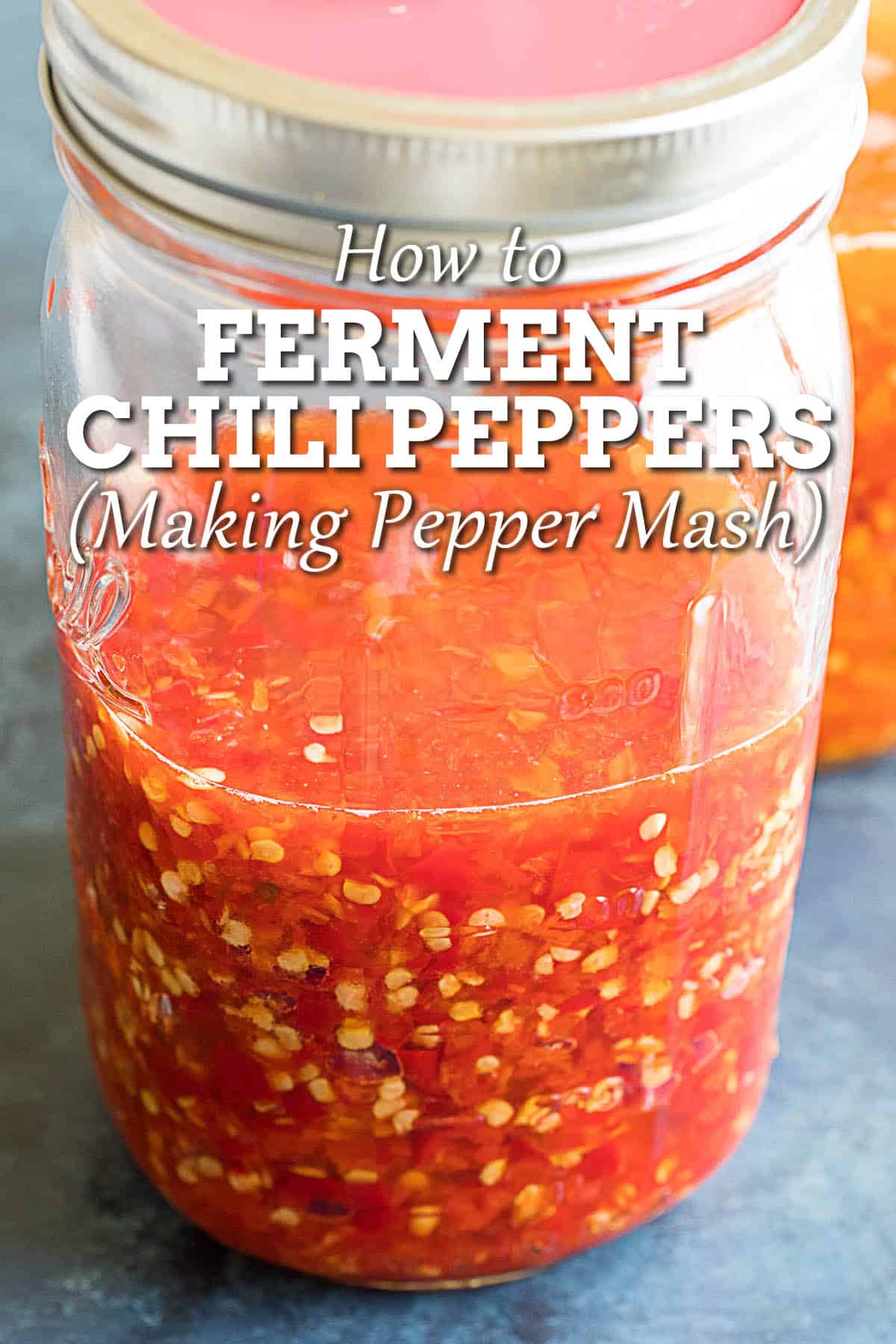
How to Ferment Peppers (Make Pepper Mash)
There are many ways to make hot sauce, and as you can tell by our Hot Sauce Recipes section of the web site, I’ve made a lot of them. However, one way we have yet to explore is making them with fermented chili peppers.
If you’ve ever enjoyed Tabasco sauce, you’ve tasted fermented chili peppers. Tabasco starts with tabasco peppers which they crush, mix with salt, and ferment in oak barrels for up to 3 years. The original Tabasco sauce only uses 3 ingredients – tabasco peppers, salt, and distilled vinegar.
A number of hot sauce makers use fermented peppers in the form of pepper mash to make their products, and a good pepper mash makes a difference in the resulting flavors. If you’re interested in making sauces from pepper mash, good news. It’s easy to make at home and you don’t need to wait 3 years for it to be ready.
But first…
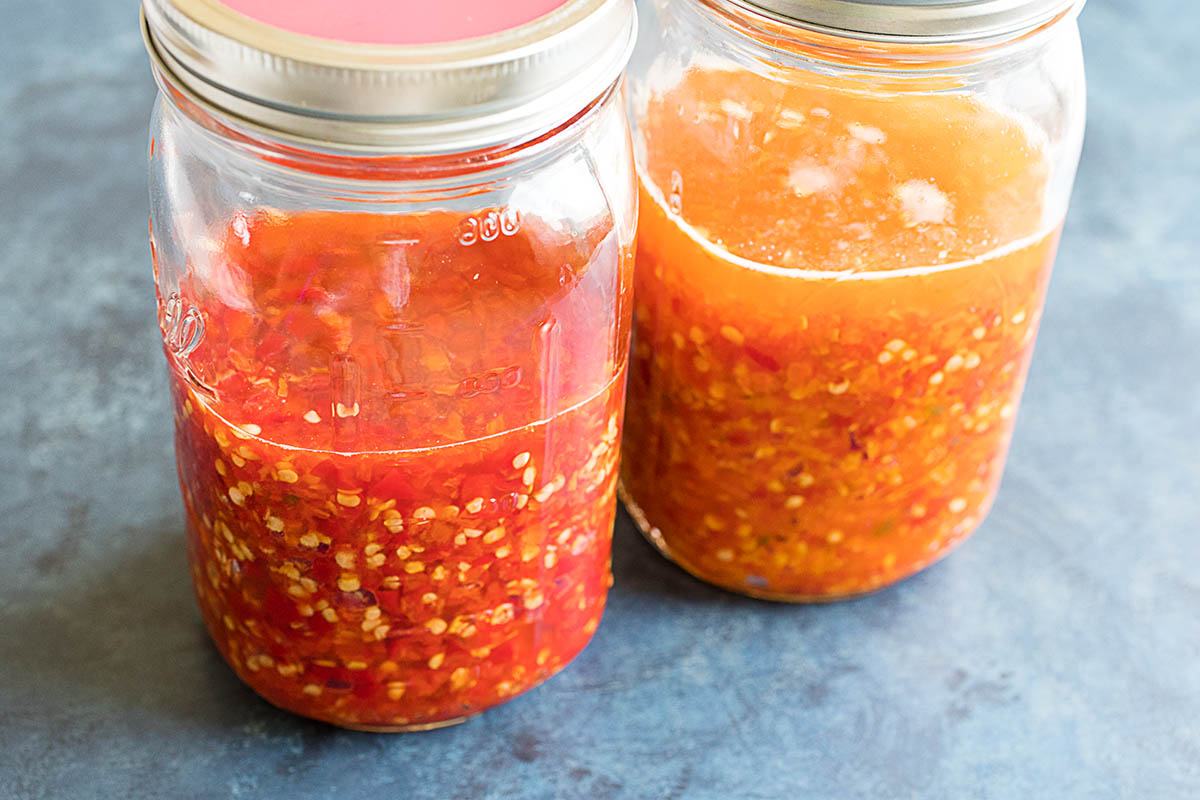
What is Fermented Pepper Mash?
Pepper mash is a collection of chili peppers that have been mashed together with salt then aged until they break down chemically. Fermentation is one our oldest methods of food preservation. Humans have preserved many foods this way, from cheeses to wine to a slew of other vegetables.
Fermentation, basically, is the decomposition of foods by micro-organisms (Lactic Acid Bacteria) or enzymes. We create an anaerobic (no oxygen) environment for the peppers so the natural Lactic Acid Bacteria can thrive, and other undesirable bacteria cannot.
Bad bacteria, such as rotting molds, cannot survive in an anaerobic environment, which we create with salt and brine, therefore protecting the peppers while the good bacteria do their work. The salt is not actually the preservative. It is the acid produced by the fermentation process that does the preserving.
Lactic acid bacteria consumes carbohydrates in the peppers and converts them to acid. After fermenting, the carbohydrates have been predigested, leaving them with more vitamins and flavor than fresh peppers.
It is akin to a controlled decay process, and there are numerous benefits to fermentation, including more digestible foods and more desirable flavors. With peppers, you’ll notice a mellowing of flavors, changes in color, and in the pleasant smell of the resulting mash.
How Safe is Fermenting Peppers?
Fermenting peppers is very safe! Before I began my exploration into fermentation, I succumbed to the common misconception that fermenting could easily lead to rotten or even dangerous foods, but in truth, fermentation is very simple and hard to mess up.
The key is to ferment properly. You’ll know if you’ve made a mistake by the smell of a ferment. It will smell “off” or “rotten”.
The fact is, we’re fermenting in a controlled environment, so just be sure to follow the proper procedures.
Making Basic Pepper Mash
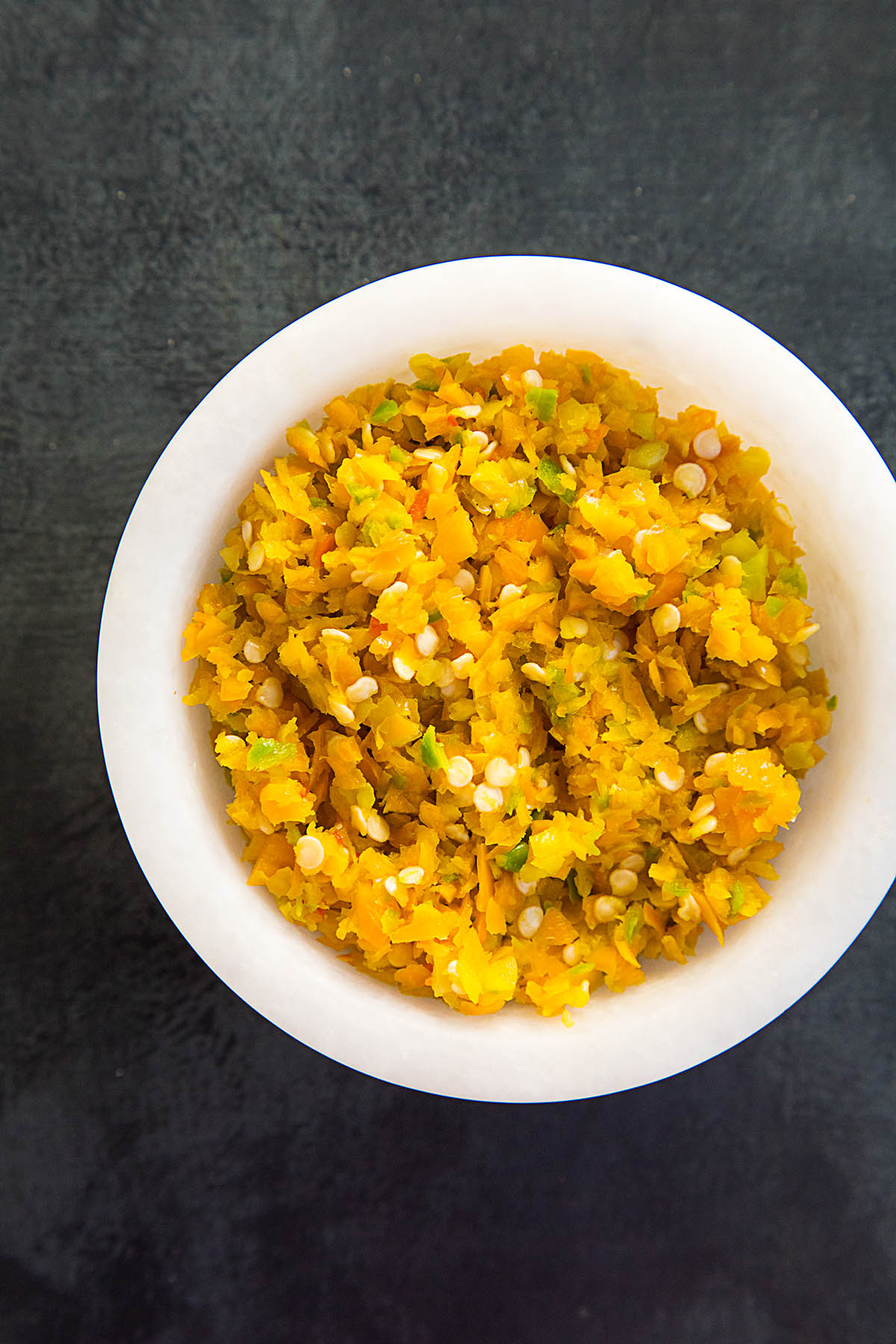
You can make fermented pepper mash from any type of chili pepper, even dried peppers. Your only consideration is the thickness of the pepper walls. Thicker walled peppers may need to be strained after the fermentation period, to remove the coarser skin, so you don’t need to seed them if you don’t want to.
Thinner walled peppers won’t need straining, so you may want to seed them first if you prefer a smoother result when you process the mash later on.
To make pepper mash, first process your fresh peppers in a food processor. If you don’t have a processor, use a mortar and pestle or simply finely chop them.
Next, mix in salt. You should use 1-2 teaspoons salt (5.69 - 11.38 g) per pound (.45 kg) of peppers. 1 pound of peppers should process down to about 1 cup of mash. So, use 1 teaspoon of salt per cup of mash, which is roughly 2.3% salt by weight.
Resources vary in their salt recommendations. Most recommend 2-5% by weight and up to 10%, with 2-3% being ideal.
The peppers will begin to release their moisture right away. A note about salt: most salts are fine to use, but avoid using salts with additives, such as table salt.
Place your mash into a jar and press it down to remove any air pockets. Leave at least 1 inch (2.54 cm) of headspace. The peppers may rise a bit when fermenting. The brine will rise up and cover the peppers. It is important to keep the peppers covered with brine to avoid spoilage. Check this daily.
Screw on the lid and set the jar away from direct sunlight to ferment for at least 1 week. Ideal temperatures are between 55-75 degrees F (12.78-23.89 C). The most active fermentation period is between 1-2 weeks, so be sure to monitor it during this time. “Burp” the jars often by unscrewing the lid a bit to let out some of the accumulating gases. Or, use an airlock or membrane for easier fermenting. See below for what I like to use.
After 1-2 weeks, the fermenting activity will diminish. Move it to a pantry where you can let it ferment longer if you’d like, or use it right away. You can ferment for months or even longer to allow the flavors to more fully develop.
Once it is ready, store it in the refrigerator where it will last for a year or longer.
Making Brine Pepper Mash
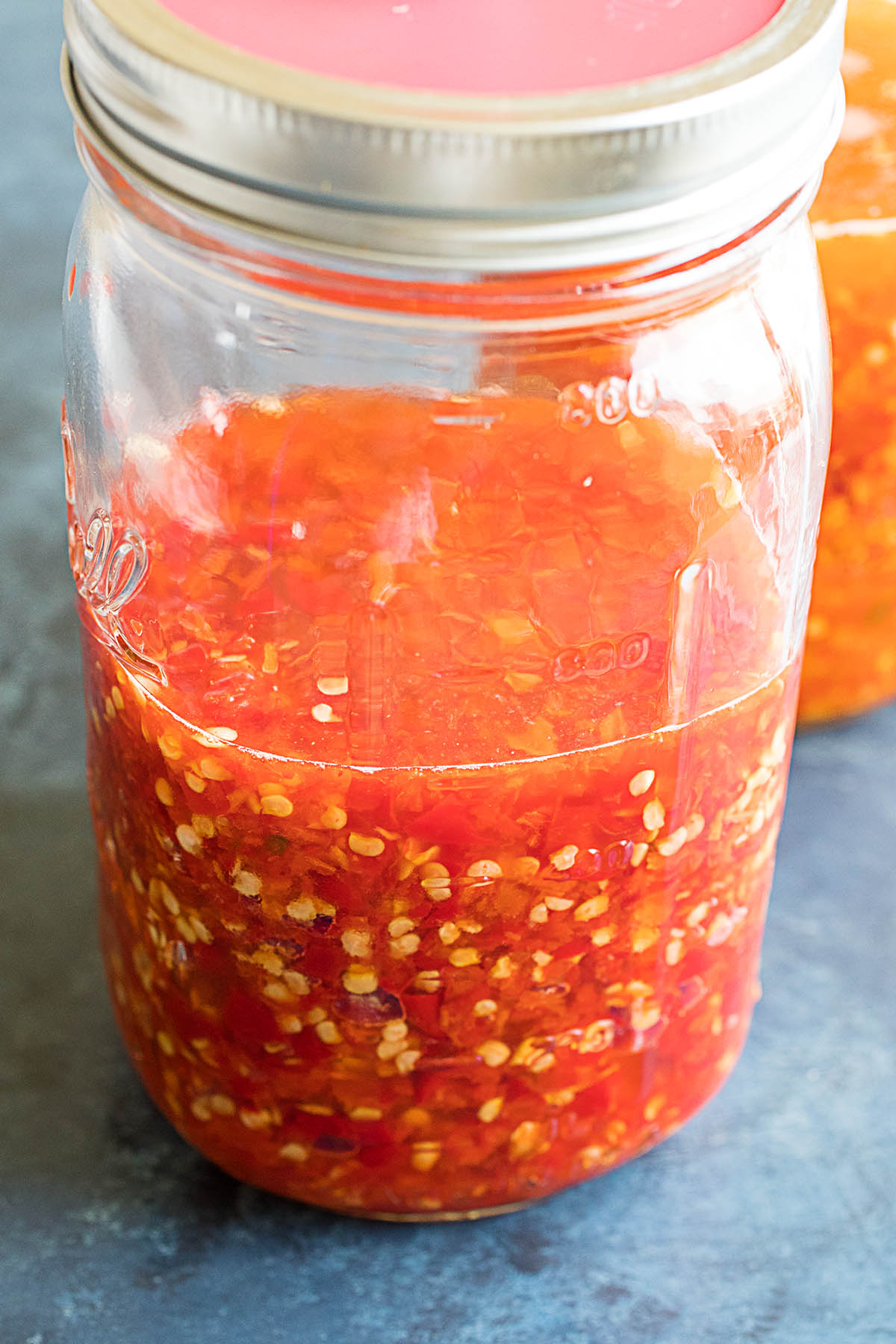
An alternate method to the basic pepper mash is using a brine, which is a salt water solution. The primary difference is that we’re adding water rather than using the natural juices from the peppers. This method ensures the peppers stay beneath the brine, and is more ideal for thinner walled peppers.
To make a brine pepper mash, first chop your fresh peppers. You can process in a food processor or use a mortar and pestle or simply finely chop them. Pack them into a jar, leaving at least 1 inch of head space. The peppers may rise a bit when fermenting.
Next, mix 1 quart (.95 liter) unchlorinated water with 1.5 (27 g, for 3% brine) to 3 tablespoons (54 g, for 6% brine) sea salt. Pour just enough brine over the peppers to cover them, pressing them down a bit as you go. It is important to keep the peppers covered with brine to avoid spoilage. Check this daily.
Screw on the lid and set the jar away from direct sunlight to ferment for at least 1 week. Ideal temperatures are between 55-75 degrees F (12.78-23.89 C). The most active fermentation period is between 1-2 weeks, so be sure to monitor it during this time. “Burp” the jars often by unscrewing the lid a bit to let out some of the accumulating gases. Or, use an airlock or membrane for easier fermenting. See below for what I like to use.
After 1-2 weeks, the fermenting activity will diminish and the brine will turn cloudy and taste acidic. Move it to a pantry where you can let it ferment longer if you’d like, or use it right away. You can ferment for months or even longer to allow the flavors to more fully develop.
Once it is ready, process it with a food processor. You can use it right away to make hot sauce or store it in the refrigerator where it will last for a year or longer.
I personally like to add a bit of vinegar at this stage before storage.
Good luck, and happy fermenting! Let me know what you make with your pepper mash.
Frequently Asked Questions about Fermenting Peppers and Making Pepper Mash
Best Salt for Fermenting Peppers
When fermenting chilies, it is important to use salt that does not contain anti-caking agents or iodine, as these can inhibit the natural fermentation process. Here are some types of salt that are commonly used for fermenting chili peppers:
- Non-iodized Sea Salt. Sea salt is a popular choice for fermenting chili peppers, as it is minimally processed and typically does not contain anti-caking agents or iodine. Look for non-iodized sea salt, which is readily available in most grocery stores.
- Kosher Salt. Kosher salt is a coarse-grained salt that dissolves easily in water, making it suitable for fermenting. Like sea salt, kosher salt does not usually contain anti-caking agents or iodine, but it's important to check the packaging to make sure.
- Pickling Salt. Pickling salt is specifically formulated for preserving and fermenting vegetables, making it a good choice for fermenting chili peppers. It is fine-grained and dissolves easily in water, ensuring even distribution of salt in the fermentation brine.
- Himalayan Pink Salt. Himalayan pink salt is a natural salt that is often used in fermenting and has gained popularity for its trace mineral content and unique flavor. It is typically non-iodized and does not contain anti-caking agents, making it suitable for fermenting chili peppers.
When fermenting chili peppers, it's important to use the right amount of salt according to your recipe or fermentation process. Too little salt can lead to spoilage or mold growth, while too much salt can inhibit fermentation.
Why Does My Pepper Mash Taste Bitter?
I sometimes get some bitterness with my fermented pepper batches. I've seen a lot of discussion on it, whether it is from kahm yeast or from the starting peppers themselves, where the slight bitterness is amplified in the fermentation process. The best way to counter it is through the addition of other ingredients.
Also, some people report a bitterness from the pepper seeds, so try removing the seeds before fermentation and see if that affects your resulting flavor.
To counterbalance the bitterness, try adding an acid like vinegar or lime juice, which can help balance it out, then a sweetener like sugar or honey. Certain roasted vegetables can help, too, like carrots or other flavors. Garlic is good. They can all help balance out the bitterness. Give the final sauce time to rest and let the flavors meld in the refrigerator.
What is Kahm Yeast?
Kahm yeast is a whitish film that can sometimes appear on top of your ferment. It can form when all of the sugar in your ferment is consumed. The PH drops because of lactic acid buildup, allowing kahm yeast to form. It is not a mold, and can be scraped away from your ferment.
Sweeter vegetables, particular peppers, are more prone to kahm yeast.
How do I tell if peppers are fermenting?
You will often see bubbling activity in the jar as the fermentation process takes place, but not always. Sometimes you may have what is called a "quiet ferment", where it seems little activity it taking place. Fermenting peppers give off a slightly sour, pleasent smell, so trust your nose to know fermentation is taking place.
How Do You Know if the Fermentation is Bad?
You can usually tell if a fermentation is bad by sight or smell. If you see signs of fuzzy or pinkish colored mold, the ferment is infected. If the peppers are very mushy, something has gone wrong.
If the ferment smells rotten or disgusting to you, it has gone bad. Trust your nose to know if something is bad. A good ferment will have a slightly sour smell, but will smell pleasant.
Hot Sauce Recipes with Fermented Peppers
Here are some of my own recipes that use fermented chili peppers.
- Fermented Hot Sauce Recipe
- Homemade Sriracha Hot Sauce
- Fermented Aji-Garlic Hot Sauce
- Homemade Louisiana Hot Sauce
- Spicy Serrano Hot Sauce
Check out more Hot Sauce Recipes or learn more about How to Make Hot Sauce. Also see my post on Homemade Kimchi (How to Make Kimchi).
The best ph meters that I recommend are from Thermoworks. Get yourself a ph meter from Thermoworks today. I am a happy affiliate.
Got any questions? Please contact me anytime and I will do my best to help. Good luck with your pepper fermentation!
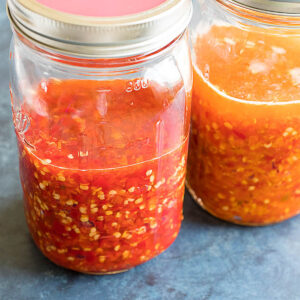
How to Ferment Chili Peppers (Pepper Mash Recipe)
Ingredients
FOR BASIC PEPPER MASH
- 1 pound chili peppers stemmed and roughly chopped (cored and seeded, if desired)
- 1 teaspoon salt
FOR BRINE PEPPER MASH
- 1 pound chili peppers stemmed and roughly chopped (cored and seeded, if desired)
- 1.5-3 tablespoons salt (1.5 tablespoon (27 g, for 3% brine) to 3 tablespoons (54 g, for 6% brine))
- 1 quart unchlorinated water
Instructions
FOR MAKING BASIC PEPPER MASH
- Finely chop your peppers. You can blend them to fit more into jars, but this can make it harder to keep below the brine.
- Next, mix in salt. You should use 1 teaspoon salt (5.69 g) per pound (.45 kg) of peppers. 1 pound of peppers should process down to about 1 cup of mash. So, use 1 teaspoon of salt per cup of mash, which is roughly 2.3% salt by weight.
- The peppers will begin to release their moisture right away.
- Place your mash into a jar and press it down to remove any air pockets. Leave at least 1 inch (2.54 cm) of headspace. The peppers may rise a bit when fermenting. The brine will rise up and cover the peppers. It is important to keep the peppers covered with brine to avoid spoilage. Check this daily.
- Screw on the lid and set the jar away from direct sunlight to ferment for at least 1 week. Ideal temperatures are between 55-75 degrees F (12.78-23.89 C). The most active fermentation period is between 1-2 weeks, so be sure to monitor it during this time. “Burp” the jars often by unscrewing the lid a bit to let out some of the accumulating gases. Or, use an airlock or membrane for easier fermenting. See below for what I like to use.
- After 1-2 weeks, the fermenting activity will diminish. Move it to a pantry where you can let it ferment longer if you’d like, or use it right away. You can ferment for months or even longer to allow the flavors to more fully develop.
- Once it is ready, store it in the refrigerator where it will last for a year or longer.
FOR MAKING BRINE PEPPER MASH
- Finely chop your fresh peppers. You can blend them to fit more into jars, but this can make it harder to keep below the brine. Pack them into a jar, leaving at least 1 inch of head space. The peppers may rise a bit when fermenting.
- Next, mix 1 quart (.95 liter) unchlorinated water with sea salt. Pour just enough brine over the peppers to cover them, pressing them down a bit as you go. It is important to keep the peppers covered with brine to avoid spoilage. Use a glass weight or a baggie filled with water on top if needed to press the peppers down below the brine. Check this daily.
- Screw on the lid and set the jar away from direct sunlight to ferment for at least 1 week. Ideal temperatures are between 55-75 degrees F (12.78-23.89 C). The most active fermentation period is between 1-2 weeks, so be sure to monitor it during this time. “Burp” the jars often by unscrewing the lid a bit to let out some of the accumulating gases. Or, use an airlock or membrane for easier fermenting.
- After 1-2 weeks, the fermenting activity will diminish and the brine will turn cloudy and taste acidic. Move it to a pantry where you can let it ferment longer if you’d like, or use it right away. You can ferment for months or even longer to allow the flavors to more fully develop.
- Once it is ready, process it with a food processor. You can use it right away to make hot sauce or store it in the refrigerator where it will last for a year or longer.
- I personally like to add a bit of vinegar at this stage before storage.
Notes
Nutrition Information
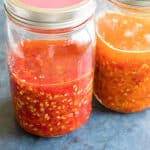


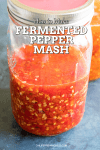
Dorie says
Hello - I'm enjoying your website so much. I am growing Cayenne peppers, and I'd like to ferment some. My question is - can I continue adding peppers to the fermentation container while it's fermenting? I'd like to be able to chop them up and put them in as I harvest them, but I don't know if it's safe to do that. Thank you for any insight.
Mike Hultquist says
Thanks, Dorie. I appreciate it. You can add as you go, though you do risk infection every time you open the jar, so it is best to be as quick and clean as possible.
Dawn H. says
Hi Mike, when you store your fermented peppers for longer term use in the pantry after the 2-week active period, I'm guessing you leave the weights or plastic bag and the burping lid in place or do you remove them? If you leave them in place, do they need to be topped off with more brime solution over time to keep the peppers submerged or does it matter at this point? Will the little bit of vinegar take care of the molding problem? For this recipe amount, how much is a bit of vinegar to add for long term storage? I like the idea of storage for later use. I fermented about a gallon of habanero peppers from my pepper garden but would like to create different recipes over time and not get into a hurried frenzy to do something with them right away. That's a bunch of peppers and I don't want them to spoil from my ignorance. Thanks for your advice. I have enjoyed your website and newsletters which have sparked many hot pepper sauce ideas.
Mike Hultquist says
Dawn, yes, I leave in the weight to make sure the peppers always stay below the brine, or they can be infected, and they still may need burping to release gases. Refrigeration will slow fermentation quite a lot. I haven't needed to top mine off, but I don't do very long ferments anymore. Top off if you need to with more brine. You won't need vinegar if fermentation is done correctly, as it creates its own acidic environment. I hope this helps.
Brian says
Interestingly I found 1lb of even a thin-walled pepper like lemon-drop peppers, finely chopped ended up filling 2 cups, not just one. Thoughts?
Going to try some jalapenos now.
Mike Hultquist says
Brian, they should still ferment the same. 1 cup vs 2 cups will really depend on how finely you chop them.
Diane says
I’ve done a couple of ferments with the brine method and going to try with the basic pepper mash. I have a lot of Ahi Mango that I think will turn out great. Does it need to be stirred at all? The others I’ve done I stirred daily.
Mike Hultquist says
You really don't need to stir, Diane, though you can if you want to. Enjoy!
Dawn Harris says
Just started a brine batch, using the mason fermentation kit with the weight. Question: do I have to remove any little bits that manage to float by the weight daily, or is it bad to open the lid completely? Thanks for the ideas and guidance in using our harvest!
Mike Hultquist says
Dawn, it's ideal to not open the lid, which can open it to infection. However, any bits floating at the top can also be exposed, so it's ideal to keep everything below the brine with a weight of some kind, like a baggie filled with a bit of water. I hope this helps.
Jamie Lynn says
New to hot sauces and fermenting...
From reading this article and some of your other recipes/comments it seems we can pretty much use any of your hot sauce recipes and ferment them as long as it is done in the approprite salt/water ratio?
Would it also be correct to say we can ferment any ratio of peppers/fruits that we want (making our own reciepes) to ferment as long as its in the approprite salt/water ratio?
Mike H. says
Jamie, welcome to the world of hot sauces! Yes, pretty much - mix and experiment searching for your favorite heat and flavor profile. While the correct ratios will ensure a safe fermentation process and the development of those flavors.